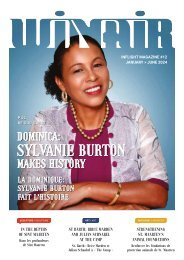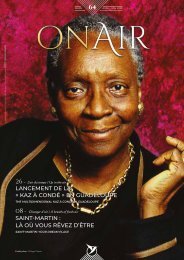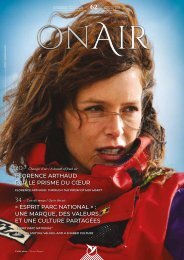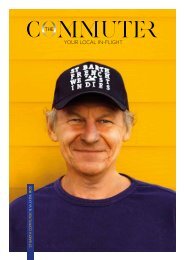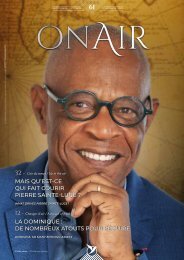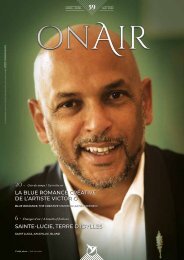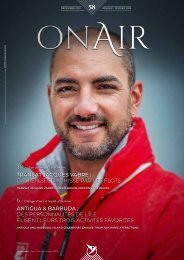TC_04_V16
Create successful ePaper yourself
Turn your PDF publications into a flip-book with our unique Google optimized e-Paper software.
ARTS / ART<br />
ARTS / ART<br />
De Natura<br />
SANCTI BARTOLOMEI<br />
Cauchemar du Bananier - 2018 -<br />
cosmopolites sordidus - origine indéterminée -<br />
stylo bille sur papier - 35,5 cm x 28 cm<br />
With the goal of exploring all aspects of his<br />
environment, de natura sancti bartolomei (Nature<br />
In Saint Barthélemy) has been brewing in the<br />
mind of Charles Moreau for the past 10 years. As his work<br />
is descriptive and informative, without representation of the<br />
subject in space, without drop shadows or depth, Charles<br />
paints according to the codes of the illustrations and plates<br />
in the encyclopedias he perused as a child. A student of<br />
natural history and “scientific curiosities,” the former antique<br />
dealer and art history expert has a strong visual culture that<br />
nourishes his work today, as he considers his environment<br />
through the prism of colonization and globalization.<br />
“With slavery and colonization, the world experienced a huge<br />
displacement of human populations, not to mention that of<br />
the animal and vegetal worlds. Westerners quickly realized<br />
they were displacing species, as the Amerindians before them<br />
had introduced turtles and “quenettier” trees to the island for<br />
the first time. Just like the uprooted humans brought to the<br />
French West Indies, many plants and animals suffered the<br />
same fate.” As a result, de natura sancti bartolomei invites<br />
us to reconsider the origins of certain flora and fauna, often<br />
erroneously considered as local. There are two ways to look<br />
at the intersection which forms the fundamental idea for<br />
this project. On one hand, the correlation between endemic<br />
and imported, which questions the origin and fragility of the<br />
species; and on the other hand, the balance between life and<br />
death.<br />
“There is more and more talk about environmental protection.<br />
And questioning the origin of a species on an island allows us<br />
to know if it is really necessary to protect it or not. In fact,<br />
there are species that disturb the food chain or the balance<br />
of our ecosystem. In doing this work, we can see what needs<br />
our protection the most is what is found under water, in our<br />
oceans. That is where the largest variety of different animal<br />
species subsist. As soon as you plunge your head under the<br />
surface, you come face to face with species that cannot as<br />
easily be transplanted. Yes these species are the victims of<br />
erosion and aggression that comes from the surface. It is this<br />
kind of thinking that I would like to encourage with this work.”<br />
An inventory through the eye of an artist, partly inspired<br />
by the aesthetic of fossils, where the subject is a life-size<br />
Avec l’ambition d’embrasser le cercle entier du sujet<br />
qu’il explore, de natura sancti bartolomei voit le jour<br />
il y a presque dix ans dans l’esprit de Charles Moreau.<br />
D’abord à but descriptif ou informatif, sans représentation du<br />
sujet dans l’espace, ombres portées ni profondeur, Charles<br />
peint selon les codes des illustrations et planches à dessins<br />
encyclopédiques de son enfance. Féru d’histoire naturelle<br />
et de “curiosités scientifiques”, l’ancien antiquaire et étudiant<br />
en histoire de l’art, fort d’une culture visuelle dont se nourrit<br />
aujourd’hui sa production, considère au demeurant son sujet<br />
à travers le prisme de la colonisation et de la mondialisation.<br />
« Avec l’esclavage et la colonisation, le monde a connu un<br />
grand bouleversement des populations humaines, mais<br />
aussi un important mélange de l’animal et du végétal. Les<br />
Occidentaux se sont vite rendu compte qu’ils charriaient des<br />
espèces, comme les Indiens avant eux avaient charrié sur<br />
l’île les tortues, quenettiers, etc., qu’on n’avait pas avant, ici. À<br />
l’instar des destinées humaines dans les Antilles, déracinées,<br />
les plantes, les animaux ont connu le même sort. » Ainsi, de<br />
natura sancti bartolomei invite à reconsidérer les origines<br />
d’une faune et d’une flore, souvent erronément considérées<br />
comme locales, à travers deux axes de réflexion — à<br />
l’intersection desquels naît l’idée fondamentale de ce projet.<br />
D’une part, la corrélation entre l’endémique et l’importé, qui<br />
questionne l’origine et la fragilité des choses ; de l’autre,<br />
l’équilibre entre la vie et la mort. « On parle de plus en<br />
plus de protection de l’environnement. Questionner l’origine<br />
des espèces sur un territoire permet de savoir ce qu’il est<br />
véritablement nécessaire de protéger ou non. Il est en effet<br />
des espèces qui viennent déséquilibrer la chaîne alimentaire<br />
ou l’équilibre d’un écosystème. À la faveur de ce travail, on se<br />
rend compte que ce qui a le plus besoin de notre protection,<br />
c’est ce qu’il y a sous l’eau, dans nos océans. C’est là que<br />
subsiste véritablement la plus grande originalité animale.<br />
Dès que vous mettez la tête sous la surface, vous faites<br />
face à des espèces qui ne peuvent être aussi facilement<br />
transplantées. Des espèces néanmoins victimes de l’érosion<br />
et d’une agression venue de la surface. C’est ce genre de<br />
réflexion que j’essaie de provoquer avec ce travail. »<br />
Un inventaire d’artiste, enfin, en partie inspiré de l’esthétique<br />
des fossiles, où le sujet est gravé dans la pierre et à taille<br />
DE NATURA SANCTI BARTOLOMEI<br />
Author / Auteur Olivier Aussedat<br />
Charles Moreau, an artist as well as curator<br />
at the Wall House Territorial Museum of Saint<br />
Barthélemy, created a compendium of the<br />
existing flora and fauna on the island with de<br />
natura sancti bartolomei, as he catalogues the<br />
island’s environment and revisits its genealogy.<br />
Compendium de la réalité animale et végétale<br />
de l’île, Charles Moreau, artiste et par ailleurs<br />
conservateur du Musée Territorial de Saint-<br />
Barthélemy propose, à travers de natura sancti<br />
bartolomei, de cataloguer notre environnement<br />
insulaire et d’en revoir la généalogie.<br />
Beau thon - 2019 - thunnus albacares - mers tropicales et sub-tropicales -<br />
huile sur toile - 107 cm x 200 cm.<br />
84<br />
the commuteR #<strong>04</strong><br />
YOUR LOCAL IN-FLIGHT<br />
85





